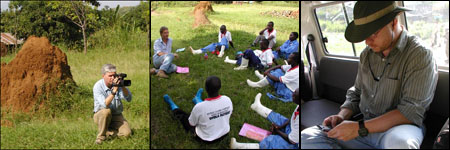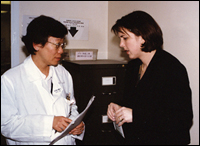CDC In the News
No Break in CDC Outbreak Investigations for the Holidays
Published: December 20, 2007
Team in Uganda on the Ebola Outbreak Investigation
Dr. Pierre Rollin
Division of Viral and Rickettsial Diseases (DVRD)/Special Pathogens Branch, Team Lead
Dr. Jordan Tappero
CDC Uganda
Dr. Eileen Farnon
DVRD/Special Pathogens Branch, Epidemiologist
Dr. Robert Downing
CDC Uganda
Debbie Canon
DVRD/Special Pathogens Branch, Laboratorian
Kelly Bartholow
CDC Uganda
Zachary Reed
DVRD/Special Pathogens Branch, Laboratorian
James Campbell
CDC Uganda
Craig Manning
DVRD/Special Pathogens Branch, Health Communications
Sundeep Gupta
CDC Uganda
Dr. Adam McNeil
DVRD/Poxvirus and Rabies Branch, EIS Officer, Epidemiologist
Linda Quick
CDC Uganda
Dr. Ann Schmitz
DVRD/Infectious Diseases Pathology Branch, Epidemiologist
Dr. Oliver Morgan
Division of Emerging Infections and Surveillance Services, EIS Officer, Epidemiologist
Dr. Phil Gould
Division of Viral Diseases, EIS Officer, Epidemiologist
Outbreak investigation teams from CDC and other international partners will work through the holidays to control and manage the current outbreak of Ebola hemorrhagic fever in Uganda.
In early December, CDC responded to a request for assistance from the Ugandan government by assembling a 10-person team to investigate an outbreak of Ebola hemorrhagic fever. The 6 epidemiologists, 3 laboratory scientists, and a communications specialist will remain in Uganda through the holiday season to manage and attempt to control the outbreak. These efforts included establishing a laboratory in Entebbe to provide diagnostics for the investigation.
Ebola hemorrhagic fever is a severe, often-fatal disease in humans and nonhuman primates (monkeys, gorillas, and chimpanzees) that has appeared sporadically since its initial recognition in 1976. The onset of illness is abrupt and is characterized by fever, headache, joint and muscle aches, sore throat, and weakness, followed by diarrhea, vomiting, and stomach pain. A rash, red eyes, and internal and external bleeding may be seen in some patients. No case of the disease in humans has ever been reported in the United States.
"Active surveillance for new cases and following contacts of known cases so that all suspected patients may be appropriately isolated is central to interrupting the chains of transmission. There are many dedicated people in all the responding organizations who will work together to ensure that surveillance, testing, clinical care, and public education continue through the holidays." Says Dr. Eileen Farnon, a medical epidemiologist stationed in Bundibugyo district, the epicenter of the outbreak investigation.

On assignment in Uganda for Ebola Outbreak Investigation
1. Craig Manning, Health Communication Specialist
2. Dr. Oliver Morgan, Epidemiologist
3. Dr. Phil Gould, Epidemiologist
The Ebola outbreak, confirmed by CDC's Special Pathogens Branch, has resulted in 123 cases and 34 deaths and is caused by what may be a novel Ebola virus. CDC team members are working with the Ugandan Ministry of Health, Médicins sans Frontière, WHO, and other international partners to provide laboratory diagnosis of cases, epidemiologic investigation and surveillance, and assist in social mobilization efforts to educate people in affected areas about how to reduce their risk of contracting the virus.
"The Ugandan social mobilization effort was already underway when we arrived, and has grown stronger and better informed daily," says Craig Manning, CDC health communications specialist who is assisting with the social mobilization efforts. "Today, we have educational messages playing on the local radio as often as 24 times per day, in three languages. We miss our families, but we appreciate the importance of the work at hand. If we can get messages quickly to the people most at risk, we can prevent illnesses and deaths."

Hong Kong 1997 — Dr. W. Lim, who first cultured the then rare H5N1 strain, discusses results with CDC EIS officer, Dr. Carolyn Bridges.
Working through the holiday season is not unusual for CDC staff. In 2000, CDC staff worked through the holidays to control an outbreak of Ebola hemorrhagic fever in the Gulu, Masindi, and Mbarara districts of Uganda, which resulted in 425 illnesses and 224 deaths. In late 2004 and early 2005, CDC staff assigned to Thailand, India, and Vietnam cut short their holidays to respond to the catastrophic tsunami that affected Indonesia and other parts of Southeast Asia.
A decade ago, CDC professionals were in Hong Kong through the holidays to control the first known human outbreak of Avian Influenza H5N1 and determine whether this influenza virus qualified as a potential pandemic influenza virus strain. The 1997 outbreak, before it was contained, resulted in 18 confirmed cases and 6 deaths. Monitoring of H5N1 continues today: A primary goal of avian flu monitoring is to identify any outbreak of human-to-human transmission quickly so health officials can attempt to contain and control the outbreak. Avian (or bird) flu (AI) is caused by influenza viruses that occur naturally among wild birds. Highly pathogenic H5N1 is deadly to domestic fowl, can be transmitted from birds to humans, and is deadly to humans. There is virtually no human immunity and human vaccine availability is very limited.
Other CDC staff will also remain vigilant for signs of any new outbreaks during the holidays. Surveillance, monitoring and tracking disease outbreaks helps health officials allocate resources effectively and efficiently. Epidemiologists use monitoring data to predict where and how disease might spread. It is important to not only know where disease outbreaks begin in the world, but also how and where they might spread in the United States.
The CDC Director's Emergency Operations Center (DEOC) is the agency's command center in Atlanta for the coordination of emergency response to domestic and international public health threats and is staffed 24 hours seven days a week, including the holidays.
"Oddly enough I don't mind being here. I prefer to manage the lighthouse—it's hard to explain, but if anything is going to happen over the holidays I want to be at my post," said Russell Baker, duty officer, and CDC Lockheed Martin contractor.
The DEOC is equipped with state-of-the-art communications technologies to support coordination with state, federal and international partners. The DEOC is also the contact for state health agencies for reporting potential public health threats. The DEOC averages about 40 calls a day and continues to support CDC staff deployed around the world. During the holidays, the DEOC's current operations remain at regular staffing.
CDC Global Disease Detection Centers in Kenya, Thailand, and Guatemala will also be vigilant over the holidays. "Unfortunately, infectious diseases don't pay attention to holidays or boundaries," said Scott Dowell, MD, chief of CDC's Global Disease Detection (GDD) program. "Our global network of GDD Centers and our operations center in Atlanta will stay connected so we can respond immediately to an outbreak that threatens the lives of people here at home or in other parts of the world." CDC remains watchful while wishing all safe and happy holidays.
Content source: Centers for Disease Control and Prevention
